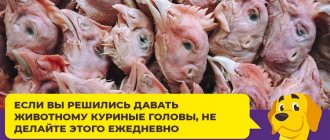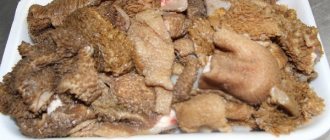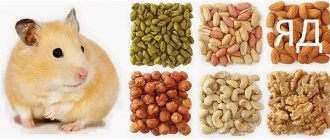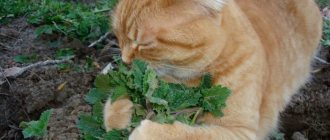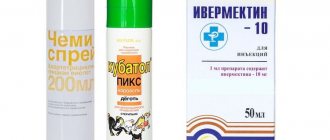Any supporter of natural nutrition asked the question: “Can dogs have oatmeal (rolled oatmeal) and how to cook it?” In general, canines are carnivores, but it is impossible to completely remove food of plant origin from their diet. This is due to the fact that cereals, herbs and vegetables contain useful minerals and vitamins that are not found in meat and fish.
Because of this, oatmeal is becoming one of the most popular cereals when cooking for pets. Firstly, it is quite cheap. Secondly, it is in every home and is present even in the human diet. But you need to understand how to properly give oatmeal to a dog so that he does not develop an allergy and does not have indigestion. First things first.
Is it possible to give oatmeal to dogs?
Dogs can have rolled oats and oatmeal without sugar. This is due to the fact that both types of cereals contain a lot of fiber, fats, and healthy minerals. Oatmeal has a high calorie content, which allows you to satiate your pet faster than the same meat by-products.
Benefits of porridge
Oatmeal contains many microelements and chemicals that are beneficial for your pet, stimulating the functioning of various organ systems. This is the main benefit of oatmeal for dogs. The list of the most concentrated beneficial substances in rolled oats includes:
- Potassium and calcium. They strengthen the animal’s skeleton and promote rapid muscle gain.
- Plant proteins. They give the pet enough energy.
- Vitamins E, PP, K, B, A. They cleanse the dog’s blood, stabilize the functioning of the nervous system, and improve vision.
- Amino acids. They help maintain nitrogen balance in the dog’s body.
Oatmeal also contains sulfur, phosphorus, manganese, iodine, fluorine, nickel and iron. These substances strengthen the immune system, promote proper blood flow, stabilize blood pressure, and maintain the overall level of health of the individual, regardless of its age. All the properties of the porridge together make it optimal for feeding individuals suffering from heartburn, digestive disorders, and gastritis. Veterinarians believe that boiled oatmeal can also be given to pregnant or lactating pets, since they especially need energy and easily digestible microelements.
Does it harm the pet's health?
Despite all the advantages of oatmeal, inexperienced breeders are inclined to believe that the benefits of oatmeal for dogs are less harmful. They explain this by the fact that in nature, dogs and their closest relatives eat mainly meat. However, pets should have a balanced diet, especially if they are purebred and have congenital digestive problems. Another argument against oatmeal is that it is high in calories. This is true, so do not give oatmeal or any products containing it to inactive pets.
There is also a widespread belief among breeders that flakes and cereals are added to dog food to create the illusion of satiety. This is explained by the fact that cereals are supposedly slowly digested and simply accumulate in the stomach and intestines. But this is not true: cereals are important because they are the main source of fiber and calories.
The benefits of rolled oats
No one doubts the benefits of oatmeal for people - many nutritionists call it the most valuable porridge. But for our four-legged pets, not everything is so simple. The main porridge in a dog's diet is usually rice and buckwheat.
Oatmeal differs from these cereals by being higher in calories and containing more fat and fiber. Fiber in small doses is very useful for dogs - they are given porridge primarily to compensate for its deficiency.
Oatmeal also contains:
- amino acids;
- vegetable protein;
- vitamin B group, vitamin E, as well as A, K and PP;
- minerals - iron and magnesium, iodine and fluorine, nickel, phosphorus, sulfur, manganese;
- potassium and calcium.
All of these elements are also beneficial for animals, and it is because of them that many veterinarians recommend this cereal as mineral support.
Another advantage of oatmeal is that it is a dietary cereal due to its wonderful enveloping property. It is distributed over the walls of the stomach, preventing gastric juice from affecting them. As a result, oatmeal will be the optimal food for dogs suffering from gastritis or gastrointestinal disorders, weakened and sick pets, as well as puppies.
And finally, the advantage of oatmeal for dogs, which is unlikely to be appreciated by the pet, but the owner will definitely be pleased with it - this cereal is inexpensive. It is no secret that oatmeal is often introduced into the diet simply to create a feeling of satiety in the animal.
This especially applies to large breeds, which are problematic to feed with clean meat. But you shouldn’t be overzealous: porridge should account for no more than 20-35% of a dog’s diet.
Can an animal be allergic to this cereal?
Dogs can develop food allergies at any age. So you need to give oatmeal to your dog carefully, unless special tests have been done before. You should not feed rolled oats to a dog that has tested positive. Otherwise, symptomatic therapy will have to be carried out, as the animal will develop a severe rash and itching. An advanced allergy can become chronic. To prevent this, do not choose an allergy medicine on your own, contact your veterinarian and follow his recommendations. Typically, specialists prescribe:
- Tavegil.
- Cetrin.
- Claritin.
- Suprastin.
- Loratadine.
If the allergy to rolled oats was particularly acute, you will have to change your diet after the final cure. Make sure that the basis of the new diet is vegetables and meat. Add fruit occasionally, but don't experiment with it - problems with allergic reactions are likely to continue.
conclusions
Grain-containing foods provide energy and other nutrients to domestic dogs, which have evolved the ability to digest and utilize them. Some specific diseases may be associated with the presence of certain grains, including gluten sensitivity leading to gastrointestinal or possibly multisystem symptoms, and food allergies causing gastrointestinal or dermatological symptoms. However, the prevalence of grain food allergies is low, confirmed gluten sensitivity is very rare, and these conditions are managed by introducing a grain-free diet.
Inadequate recommendations with no scientific basis support the marketing of grain-free dog diets.
Mike Davis, DVM
Links:
- Adolphe JL, Drew MD, Huang Q, Silver TI and Weber LP (2012). Postprandial impairment of flow-mediated dilation and elevated methylglyoxal after simple, but not complex, carbohydrate consumption in dogs, Nutr Res 32(4): 278-284.
- Axelsson E, Ratnakumar A, Arendt MJ, Maqbool K, Webster MT, Perloski M, Liberg O, Arnemo JM, Hedhammar A and Lindblad-Toh K (2013). The genomic signature of dog domestication reveals adaptation to a starch-rich diet, Nature 495(7,441): 360-364.
- Backus RC, Cohen G, Pion PD, Good KL, Rogers QR and Fascetti AJ (2003). Taurine deficiency in Newfoundlands fed commercially available complete and balanced diets, J Am Vet Med Assoc 223(8): 1,130-1,136.
- Batt RM, Carter MW and McLean L (1985). Wheat-sensitive enteropathy in Irish setter dogs: possible age-related brush border abnormalities, Res Vet Sci 39(1): 80-83.
- Bazolli RS, Vasconcellos RS, de-Oliveira LD, Sá FC, Pereira GT and Carciofi AC (2015). Effect of the particle size of maize, rice, and sorghum in extruded diets for dogs on starch gelatinization, digestibility, and the fecal concentration of fermentation products, J Anim Sci 93(6): 2,956–2,966.
- Beaufrand MJ, de la Guérivière JF, Monnier C and Poullain B (1978). Effect of the extrusion process on the availability of proteins, Ann Nutr Aliment 32(2-3): 353-364.
- Bednar GE, Patil AR, Murray SM, Grieshop CM, Merchen NR and Fahey GC Jr (2001). Starch and fiber fractions in selected food and feed ingredients affect their small intestinal digestibility and fermentability and their large bowel fermentability in vitro in a canine model, J Nutr 131(2): 276-286.
- Beloshapka AN, Alexander LG, Buff PR and Swanson KS (2014). The effects of feeding resistant starch on apparent total tract macronutrient digestibility, faecal characteristics and faecal fermentative end-products in healthy adult dogs, J Nutr Sci 3: e38.
- Belavady B and Gopalan C (1965). Production of black tongue in dogs by feeding diets containing jowar (Sorghum vulgare), Lancet 2(7,424): 1,220.
- Breitschwerdt EB, Hirakawa DA, Hurlbert SA, Gerig TM and Babineau C (1992). Effects of dietary protein source on Basenjis with immunoproliferative enteropathy, Am J Vet Res 53(2): 234-236.
- Brown WY, Vanselow BA, Redman AJ and Pluske JR (2009). An experimental meat-free diet maintained haematological characteristics in sprint-racing sled dogs, Br J Nutr 102(9): 1.318-1.323.
- Bruchim Y, Segev G, Sela U, Bdolah-Abram T, Salomon A and Aroch I (2012). Accidental fatal aflatoxicosis due to contaminated commercial diet in 50 dogs, Res Vet Sci 93(1): 279-287.
- Burns RA, LeFaivre MH and Milner JA (1982). Effects of dietary protein quantity and quality on the growth of dogs and rats, J Nutr 112(10): 1.843–1.853.
- Campos SG, Cavaglieri LR, Fernández Juri MG, Dalcero AM, Krüger C, Keller LA, Magnoli CE and Rosa CA (2008). Mycobiota and aflatoxins in raw materials and pet food in Brazil, J Anim Physiol Anim Nutr (Berl) 92(3): 377-383.
- Carciofi AC, Takakura FS, de-Oliveira LD, Teshima E, Jeremias JT, Brunetto MA and Prada F (2008). Effects of six carbohydrate sources on dog diet digestibility and post-prandial glucose and insulin response, Anim Physiol Anim Nutr (Berl) 92(3): 326-336.
- Case L. P. and Czarnecki-Maulden G. L. (1990). Protein requirements of growing pups fed practical dry-type diets containing mixed-protein sources, Am J Vet Res 51(5): 808-812.
- Davies M (2016). Gluten exposure and multisystem disease in dogs, Vet Rec 179(22): 570-571.
- de Godoy MR, Knapp BK, Parsons CM, Swanson KS and Fahey GC Jr (2014). In vitro hydrolytic digestion, glycemic response in dogs, and true metabolizable energy content of soluble corn fibers, J Anim Sci 92(6): 2,447–2,457.
- Delaney SJ, Kass PH, Rogers QR and Fascetti AJ (2003). Plasma and whole blood taurine in normal dogs of varying size fed commercially prepared food, J Anim Physiol Anim Nutr (Berl) 87(5-6): 236-244.
- Delorme CB, Barrette D, Mongeau R and Larivière N (1985). The effect of dietary fiber on feed intake and growth in beagle puppies, Can J Comp Med 49(3): 278–285.
- Dobson RL, Motlagh S, Quijano M, Cambron RT, Baker TR, Pullen AM, Regg BT, Bigalow-Kern AS, Vennard T, Fix A, Reimschuessel R, Overmann G, Shan Y and Daston GP (2008). Identification and characterization of toxicity of contaminants in pet food leading to an outbreak of renal toxicity in cats and dogs, Toxicol Sci 106(1): 251-262.
- Fahey GC Jr, Merchen NR, Corbin JE, Hamilton AK, Serbe KA and Hirakawa DA (1990). Dietary fiber for dogs: II. Iso-total dietary fiber (TDF) additions of divergent fiber sources to dog diets and their effects on nutrient intake, digestibility, metabolizable energy and digesta mean retention time, J Anim Sci 68(12): 4,229–4,235.
- Fascetti AJ, Reed JR, Rogers QR and Backus RC (2003). Taurine deficiency in dogs with dilated cardiomyopathy: 12 cases (1997-2001), J Am Vet Med Assoc 223(8): 1,137-1,141.
- Gajda M, Flickinger EA, Grieshop CM, Bauer LL, Merchen NR and Fahey GC Jr (2005). Corn hybrid affects in vitro and in vivo measures of nutrient digestibility in dogs, J Anim Sci 83(1): 160–171.
- Garden OA, Manners HK, Sørensen SH, Rutgers HC, Daniels S, Legrand-Defretin V and Batt RM (1998). Intestinal permeability of Irish setter puppies challenged with a controlled oral dose of gluten, Res Vet Sci 65(1): 23-28.
- Garden OA, Pidduck H, Lakhani KH, Walker D, Wood JL and Batt RM (2000). Inheritance of gluten-sensitive enteropathy in Irish setters, Am J Vet Res 61(4): 462-468.
- Golinski PK and Nowak T (2004). Dietary origin of mycotoxins with estrogenic potential and possible health implications to female dogs, Pol J Vet Sci 7(4): 337-341.
- Goudez R, Weber M, Biourge V and Nguyen P (2011). Influence of different levels and sources of resistant starch on faecal quality of dogs of various body sizes, Br J Nutr 106(Suppl 1): S211-S215.
- Guevara MA, Bauer LL, Abbas CA, Beery KE, Holzgraefe DP, Cecava MJ and Fahey GC Jr (2008). Chemical composition, in vitro fermentation characteristics, and in vivo digestibility responses by dogs to select corn fibers, J Agric Food Chem 56(5): 1.619-1.626.
- Guy R (2001). Extrusion Cooking: Technologies and Applications, Woodhead Publishing, Cambridge: 111–116.
- Hall EJ and Batt RM (1990a). Development of wheat-sensitive enteropathy in Irish setters: morphological changes, Am J Vet Res 51(7): 978-982.
- Hall EJ and Batt RM (1990b). Development of wheat-sensitive enteropathy in Irish setters: biochemical changes, Am J Vet Res 51(7): 983-989.
- Hall EJ and Batt RM (1990c). Enhanced intestinal permeability to 51Cr-labeled EDTA in dogs with small intestinal disease, J Am Vet Med Assoc 196(1): 91-95.
- Hall EJ and Batt RM (1991a). Sugar absorption for the assessment of canine intestinal permeability: the cellobiose/mannitol test in gluten-sensitive enteropathy of Irish setters, Res Vet Sci 51(1): 83-87.
- Hall EJ and Batt RM (1991b). Abnormal permeability precedes the development of a gluten sensitive enteropathy in Irish setter dogs, Gut 32(7): 749-753.
- Hall E. J. and Batt R. M. (1992). Dietary modulation of gluten sensitivity in a naturally occurring enteropathy of Irish setter dogs, Gut 33(2): 198-205.
- Hall EJ, Carter SD, Barnes A and Batt RM (1992). Immune responses to dietary antigens in gluten-sensitive enteropathy of Irish setters, Res Vet Sci 53(3): 293–299.
- Harper JM (1978). Food extrusion, CRC Crit Rev Food Sci Nutr 11(2): 155-215.
- Helman EE, Huff-Lonergan E, Davenport GM and Lonergan SM (2003). Effect of dietary protein on calpastatin in canine skeletal muscle, J Anim Sci 81(9): 2,199–2,205.
- Jackson HA, Jackson MW, Coblentz L and Hammerberg B (2003). Evaluation of the clinical and allergen specific serum immunoglobulin E responses to oral challenge with cornstarch, corn, soy and a soy hydrolysate diet in dogs with spontaneous food allergy, Vet Dermatol 14(4): 181-187.
- Jeffers JG, Meyer EK and Sosis EJ (1996). Responses of dogs with food allergies to single-ingredient dietary provocation, J Am Vet Med Assoc 209(3): 608-611.
- Ko K. S. and Fascetti A. J. (2016). Dietary beet pulp decreases taurine status in dogs fed low protein diet, J Anim Sci Technol 58: 29.
- Leung MC, Díaz-Llano G and Smith TK (2006). Mycotoxins in pet food: a review on worldwide prevalence and preventative strategies, J Agri Food Chem 54(26): 9,623–9,635.
- Lowe NM, Hall EJ, Anderson RS, Batt RM and Jackson MJ (1995). A stable isotope study of zinc kinetics in Irish setters with gluten-sensitive enteropathy, Br J Nutr 74(1): 69-76.
- Lowrie M, Garden OA, Hadjivassiliou M, Harvey RJ, Sanders DS, Powell R and Garosi L (2015). The clinical and serological effect of a gluten-free diet in border terriers with epileptoid cramping syndrome, J Vet Intern Med29(6): 1,564-1,568.
- Lowrie M, Hadjivassiliou M, Sanders DS and Garden OA (2016). A presumptive case of gluten sensitivity in a border terrier: a multisystem disorder? Vet Rec 179(22): 573.
- Manners HK, Hart CA, Getty B, Kelly DF, Sørensen SH and Batt RM (1998a). Characterization of intestinal morphologic, biochemical, and ultrastructural features in gluten-sensitive Irish setters during controlled oral gluten challenge exposure after weaning, Am J Vet Res 59(11): 1,435-1,440.
- Manners HK, Sørensen SH, Embaye H, Odedra RM and Batt RM (1998b). Evidence for a compensatory increase in synthesis of brush border enzymes in the jejunum of Irish setters with gluten-sensitive enteropathy, Am J Vet Res59(11): 1.392-1.397.
- McKevith B (2004). Nutritional aspects of cereals (briefing paper), Nutrition Bulletin, British Nutrition Foundation29: 111-142.
- McNaught JB, Scott VC, Woods FM and Whipple GH (1936). Blood plasma protein regeneration controlled by diet: effects of plant proteins compared with animal proteins the influence of fasting and infection, J Exp Med 63(2): 277-301.
- Merritt AM, Burrows CF, Cowgill L and Streett W (1979). Fecal fat and trypsin in dogs fed a meat-base or cereal-base diet, J Am Vet Med Assoc 174(1): 59-61.
- Mueller RS, Bettenay SV and Tideman L (2000). Aero-allergens in canine atopic dermatitis in southeastern Australia based on 1,000 intradermal skin tests, Aust Vet J 78(6): 392-399.
- Mueller RS, Oliry T and Prélaud P (2016). Critically appraised topic on adverse food reactions of companion animals (2): common food allergen sources in dogs and cats, BMC Vet Res 12: 9.
- Murray SM, Fahey GC Jr, Merchen NR, Sunvold GD and Reinhart GA (1999). Evaluation of selected high-starch flours as ingredients in canine diets, J Anim Sci 77(8): 2,180–2,186.
- Murray SM, Flickinger EA, Patil AR, Merchen NR, Brent JL Jr and Fahey GC Jr (2001). In vitro fermentation characteristics of native and processed cereal grains and potato starch using ileal chyme from dogs, J Anim Sci79(2): 435-444.
- Nery J, Goudez R, Biourge V, Tournier C, Leray V, Martin L, Thorin C, Nguyen P and Dumon H (2012). Influence of dietary protein content and source on colonic fermentative activity in dogs differing in body size and digestive tolerance, J Anim Sci 90(8): 2,570-2,580.
- Nogata Y, Nagamine T, Yanaka M and Ohta H (2009). Angiotensin I converting enzyme inhibitory peptides produced by autolysis reactions from wheat bran, J Agric Food Chem 57(15): 6,618-6,622.
- Nogata Y and Nagamine T (2009). Production of free amino acids and gamma-aminobutyric acid by autolysis reactions from wheat bran, J Agric Food Chem 57(4): 1,331-1,336.
- Olivry T, Kurata K, Paps JS and Masuda K (2007). A blinded randomized controlled trial evaluating the usefulness of a novel diet (aminoprotect care) in dogs with spontaneous food allergy, J Vet Med Sci 69(10): 1.025-1.031.
- Pacheco GF, Marcolla CS, Machado GS, Kessler AM and Trevizan L (2014). Effect of full-fat rice bran on palatability and digestibility of diets supplemented with enzymes in adult dogs, J Anim Sci 92(10): 4,598–4,606.
- Panasevich MR, Kerr KR, Serao MC, de Godoy MR, Guérin-Deremaux L, Lynch GL, Wils D, Dowd SE, Fahey GC, Swanson KS and Dilger RN (2015). Evaluation of soluble corn fiber on chemical composition and nitrogen-corrected true metabolizable energy and its effects on in vitro fermentation and in vivo responses in dogs, J Anim Sci 93(5): 2,191-2,200.
- Pang JF, Kluetsch C, Zou XJ, Zhang AB, Luo LY, Angleby H, Ardalan A, Ekström C, Sköllermo A, Lundeberg J, Matsumura S, Leitner T, Zhang YP and Savolainen P (2009). mtDNA data indicate a single origin for dogs south of Yangtze River, less than 16,300 years ago, from numerous wolves, Mol Biol Evol 26(12): 2,849-2,864.
- Paterson S (1995). Food hypersensitivity in 20 dogs with skin and gastrointestinal signs, J Small Anim Pract 36(12): 529-534.
- Pemberton PW, Lobley RW, Holmes R, Sørensen SH and Batt RM (1997). Gluten-sensitive enteropathy in Irish setter dogs: characterization of jejunal microvillar membrane proteins by two-dimensional electrophoresis, Res Vet Sci 62(2): 191-193.
- Pestka JJ and Smolinski AT (2005). Deoxynivalenol: toxicology and potential effects on humans, J Toxicol Environ Health B: Crit Rev 8(1): 39-69.
- Pommerenke W. T., Slavin H. B., Kariher D. H. and Whipple G. H. (1935). Blood plasma protein regeneration controlled by diet: systematic standardization of food proteins for potency in protein regeneration. fasting and iron feeding, J Exp Med 61(2): 261–282.
- Pouteau E, Dumon H, Biourge V, Krempf M and Nguyen P (1998). Hydrogen production in dogs adapts to addition of lactulose and to a meat and rice diet, J Nutr 128(Suppl 12): 2.666S-2.668S.
- Rice J E and Ihle S L (1994). Effects of diet on fecal occult blood testing in healthy dogs, Can J Vet Res 58(2): 134-137.
- Savoie L, Charbonneau R and Parent G (1989). In vitro amino acid digestibility of food proteins as measured by the digestion cell technique, Plant Foods Hum Nutr 39(1): 93-107.
- Schick R and Schusdziarra V (1985). Physiological, pathophysiological and pharmacological aspects of exogenous and endogenous opiates, Clin Physiol Biochem 3(1): 43-60.
- Schusdziarra V, Henrichs I, Holland A, Klier M and Pfeiffer EF (1981). Evidence for an effect of exorphins on plasma insulin and glucagon levels in dogs, Diabetes 30(4): 362-364.
- Sharma S, Kishore N, Sharma K and Sharma BB (1980). Hypocholesterolemic effects of dietary fiber, Indian J Physiol Pharmacol 24(2):136–138.
- Sousa CA, Stannard AA, Ihrke PJ, Reinke SI and Schmeitzel LP (1988). Dermatosis associated with feeding generic dog food: 13 cases (1981-1982), J Am Vet Med Assoc 192(5): 676-680.
- Swanson KS, Kuzmuk KN, Schook LB and Fahey GC Jr (2004). Diet affects nutrient digestibility, hematology, and serum chemistry of senior and weaning dogs, J Anim Sci 82(6): 1,713-1,724.
- Tonoike A, Hori Y, Inoue-Murayama M, Konno A, Fujita K, Miyado M, Fukami M, Nagasawa M, Mogi K and Kikusui T (2015). Copy number variations in the amylase gene (AMY2B) in Japanese native dog breeds, Anim Genet 46(5): 580-583.
- Tôrres CL, Backus RC, Fascetti AJ and Rogers QR (2003). Taurine status in normal dogs fed a commercial diet associated with taurine deficiency and dilated cardiomyopathy, J Anim Physiol Anim Nutr (Berl) 87(9-10): 359-372.
- Twomey LN, Pethick DW, Rowe JB, Choct M, Pluske JR, Brown W and Laviste MC (2002). The use of sorghum and corn as alternatives to rice in dog foods, J Nutr 132(Suppl 6): 1.704S-1.705S.
- Vaden SL, Sellon RK, Melgarejo LT, Williams DA, Trogdon MM, VanCamp SD and Argenzio RA (2000a). Evaluation of intestinal permeability and gluten sensitivity in soft-coated wheaten terriers with familial protein-losing enteropathy, protein-losing nephropathy, or both, Am J Vet Res 61(5): 518-524.
- Vaden SL, Hammerberg B, Davenport DJ, Orton SM, Trogdon MM, Melgarejo LT, VanCamp SD and Williams DA (2000b). Food hypersensitivity reactions in soft-coated wheaten terriers with protein-losing enteropathy or protein-losing nephropathy or both: gastroscopic food sensitivity testing, dietary provocation, and fecal immunoglobulin E, J Vet Intern Med 14(1): 60-67
- Vilà C, Savolainen P, Maldonado JE, Amorim IR, Rice JE, Honeycutt RL, Crandall KA, Lundeberg J and Wayne RK (1997). Multiple and ancient origins of the domestic dog, Science 276(5,319): 1,687-1,689.
- Wakshlag JJ, Barr SC, Ordway GA, Kallfelz FA, Flaherty CE, Christensen BW, Shepard LA, Nydam DV and Davenport GM (2008). Effect of dietary protein on lean body wasting in dogs: correlation between loss of lean mass and markers of proteasome-dependent proteolysis, J Anim Physiol Anim Nutr (Berl) 87(11-12): 408-420.
- Walker JA, Harmon DL, Gross KL and Collings GF (1994). Evaluation of nutrient utilization in the canine using the ileal cannulation technique, J Nutr 124(Suppl 12): 2.672S-2.676S.
- Whipple G. H. and Robscheit-Robbins F. S. (1951). Anaemia plus hypoproteinemia in dogs; various proteins in diet show various patterns in blood protein production; beef muscle, egg, lactalbumin, fibrin, viscera, and supplements, J Exp Med 94(3): 223-242.
- Wouters AT, Casagrande RA, Wouters F, Watanabe TT, Boabaid FM, Cruz CE and Driemeier D (2013). An outbreak of aflatoxin poisoning in dogs associated with aflatoxin B1-contaminated maize products, J Vet Diag Invest 25(2): 282-287.
- Yamada T, Tohori M, Ashida T, Kajiwara N and Yoshimura H (1987). Comparison of effects of vegetable protein diet and animal protein diet on the initiation of anemia during vigorous physical training (sports anemia) in dogs and rats, J Nutr Sci Vitaminol (Tokyo) 33(2): 129-149.
Source: Cereals and grains found in dog food – a health benefit or risk?
See also:
- Dogs see the world differently than people
- To cut or not to cut: what do we know about the properties of fur and thermoregulation in dogs
- Quality of life for dogs
- Can dogs make and use tools?
- Is this dog really happy?
- The sad truth about dogs and depression
- Possibilities and limitations of genetic testing in dogs
- Do dog breeds differ in pain sensitivity?
- How does your dog's nose know so much?
- It's all in the mother's genes: a new discovery in hereditary eye diseases in dogs
- 200
Shared - 29
- 168
- 3
Which dogs are contraindicated for oatmeal?
Before answering more detailed questions like “How long to cook rolled oats in water for dogs?”, you need to understand whether a puppy of a particular breed can eat this cereal. A number of breeds: pugs, bulldogs and the like do not tolerate excess grains in the diet, they are prone to rapid weight gain, and spend few calories due to passivity. But for large pets intended for work or protection (shepherd dogs, Alabais, St. Bernards), oatmeal is a must. Such breeds eat a lot, so completely limiting their diet to meat and by-products of its processing will be too expensive.
How to properly prepare oatmeal for your pet?
1. Put water on fire.
2. Boil water. 3. Pour the cereal into boiling water. Cook for 10 minutes, stirring while doing so. 4. Cover with a lid and let it brew. Dogs simply won’t eat oatmeal in its pure form, so you’ll have to cook it. You can feed your dog oatmeal soaked in kefir and seasoned with sunflower oil. But usually they simply make porridge with water from cereals. It’s easy to cook rolled oats for your pet: just pour the cereal into boiling water and bring it to the desired consistency.
The oatmeal you cook for your dog must be mixed with meat. There are several approaches to adding meat: either it is simply added to the cereal and cooked all together, or it is cooked separately and the dish is mixed in a bowl. To increase the caloric intake of meat, add vegetables (carrots, pumpkin, beets) and herbs (parsley, dill). This way, the dog looking for the tastiest morsels will still get enough plant proteins for the day. But veterinarians do not recommend preparing oatmeal or oat-vegetable porridge more than once a week.
How to cook porridge: with water or milk?
For puppies, it is preferable to cook oatmeal in milk or broth.
Adult dogs do not need milk; most of them do not digest it. Whether it is necessary to cook porridge in broths is a controversial issue. Such a dish will be more aromatic and satisfying, but it may be too heavy food for the animal and will put a lot of stress on the liver. If your dog is overweight, it’s definitely not worth it.
Another option is porridge with vegetable broth. It is cooked without salt, spices, onions and garlic, from carrots, beets, bell peppers and other vegetables allowed for dogs. But, if your pet is not a fan of plant foods, convincing him to eat it will not be easy.
Recipes
Oatmeal can be cooked in two types: viscous and liquid. For 500 g of porridge you will need:
- 100 g of oatmeal, 300 ml of water - the result is a viscous porridge;
- 100 g oatmeal, 400 ml water - liquid.
If you use Hercules oatmeal, you need to take a little more water, 400-500 ml.
The cooking process is simple: pour water into a saucepan and bring to a boil. Pour in the porridge, add a little salt (4-5 g of salt, the dog doesn’t need more), wait for it to boil again and reduce the heat. Cook for 10-15 minutes, stirring occasionally.
Tip : the later the porridge is removed from the stove, the thicker it will be.
Another recipe option for dogs is rice-oatmeal porridge. For it you will need (for one medium saucepan):
- 1.5 cups rice;
- 0.5 cups oatmeal;
- 3 glasses of water (you may need more during cooking);
- salt.
The rice is washed. Water is boiled in a saucepan, then rice is poured into it and the lid is closed tightly so that steam does not escape. Cook the porridge over high heat for 10 minutes. Then you need to reduce the heat and add the oatmeal, cook for another 10 minutes. After this, remove the pan from the stove, wrap it and leave for about 20 minutes. The porridge is ready, it will turn out liquid, but appetizing.
How to give oatmeal to dogs?
Oatmeal is given to your pet in the morning or at lunch. This cereal is quite high in calories, so it will only be possible to prevent weight gain if the animal uses it all up in a day. Shift the schedule if your pet receives serious physical activity every day. But you need to take into account the dog’s health, otherwise a diet based on cereals will be harmful. For example, rolled oats for gastritis in dogs should appear on the menu no more than once every two weeks. And after surgical intervention in the digestive system, it is better to completely exclude oatmeal from the diet.
For adults
Adult dogs are given porridge or other types of food that can be cooked from oatmeal once a week. If the animal is large, the frequency increases to two or three times in seven days. There are separate rules for pregnant and lactating animals. If your dog previously ate oatmeal without problems, it is not necessary to remove it from the weekly menu. But such a dog spends a lot of energy. It will be compensated not only with cereals, but also with meat, vegetables, and special vitamins. Puppies will not be born purely on oatmeal and will not grow up healthy.
For puppies
Dog breeders often feed their babies oatmeal with milk or water. It allows you to quickly gain weight and healthy muscle mass. But veterinarians argue whether rolled oats are beneficial or not for dogs under one year of age. Most of the medical community is inclined to believe that puppies should not be given porridge until they are eight months old. It has little effect on the formation of the skeleton and can provoke loose stools. If after the first feeding of the puppy an allergy appears, you should definitely stop using rolled oats in the diet for the near future.
If all is well, create a menu for your small pet for six small meals a day. You need to make oatmeal with water three times. A little skinned and boned meat is added to it. Three times - with milk, and the finished dish must be mixed with a dairy product (kefir, fermented baked milk, low-fat cottage cheese).
After the puppy is six months old, give boiled oatmeal in larger portions. This will allow him to quickly gain weight. There is no need to fear that your pet will become obese: young dogs burn a lot of calories, so additional sources will not hurt. As soon as the dog turns one and a half years old, begin to reduce the amount of food consumed per day. By the time your dog fully matures or reaches adult body weight, you should reduce your intake of oatmeal per day to once a week.
Research methodology
An online literature search was conducted to identify scientific evidence supporting the health benefits and risks of grain-containing foods for dogs.
Statistics of the results and the number of references in PubMed are shown in the table:
A total of 98 articles reported studies involving dogs and crops and their effects on nutrition, gastrointestinal function, or disease. It was not possible to carry out a complete meta-analysis of documents, because the studies reported different topics, used different methodologies and, in some cases, the number of dogs involved was low, reducing the reliability of the statistics.
Other studies, such as those regarding the effect of the extrusion process, were also found in selected search engines, including Google.
What to do if your dog has indigestion from porridge?
Oatmeal poisoning is impossible. Hercules cereal is easily absorbed by the body. Serious problems can arise only because the dog ate sour porridge. It is important for the owner to ensure that the pet consumes only fresh food. To do this, you must not give porridge from the human table, but prepare it separately for the animal as needed.
Dealing with oatmeal allergies in dogs is more difficult than dealing with diarrhea. In general, diarrhea from rolled oats can appear either immediately after eating food, or over time while it is being digested. If your dog has diarrhea from oatmeal, you need to provide it with constant access to clean drinking water. Do not feed your pet temporarily, give him more time to rest and do not disturb him again. And when his condition returns to normal, completely eliminate cereals, and most importantly oatmeal, from the diet. If first aid measures do not help, contact your veterinarian.
What grains can be cooked for dogs?
So, what kind of cereal can you cook for dogs in order not only to provide your pet with all the essentials, but also not to harm him? The best options would be buckwheat and rice. Less often you can give oatmeal (provided that the dog is not allergic to it), rolled oats, wheat, and barley.
You can cook just “monokashi” from one type of grain, or mix several types of cereals in different proportions so that your dog doesn’t get bored of the same thing. But you should not change the “menu” often, as digestive upset will begin. It is best to give one cereal as a base, and mix the rest in smaller quantities into it. And another important point - the porridge should only be crumbly. This way it is better digested.
However, to make your diet balanced and complete, you must understand that cereals make up only a third of the daily menu. Therefore, you need to add other products to cereals. Which ones exactly, read below.
